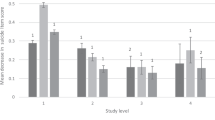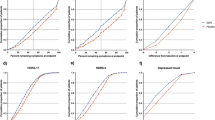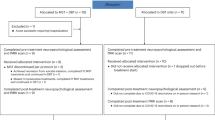Abstract
Randomized controlled trials in depressed patients selected for elevated suicidal risk are rare. The resultant lack of data leaves uncertainty about treatment in this population. This study compared a serotonin reuptake inhibitor with a noradrenergic/dopaminergic antidepressant in major depression with elevated suicidal risk factors. We conducted a double-blind, randomized, clinical pilot trial of paroxetine (N=36) or bupropion (N=38) in DSM IV major depression with a suicide attempt history or current suicidal ideation. The effects during acute (8 weeks) and continuation treatment (up to 16 weeks) were measured. Main outcomes were suicidal behavior and ideation. The secondary outcome was modified 17-item Hamilton Depression Rating Scale score subtracting the suicide item (mHDRS-17). Treatment was not associated with time to a suicidal event and no treatment main effect or treatment × time interaction on suicidal ideation or mHDRS-17 was found. Exploratory model selection showed modest advantages for paroxetine on: (1) mHDRS-17 (p=0.02); and (2) in a separate model adjusted for baseline depression, for suicidal ideation measured with the Beck Scale for Suicidal Ideation (p=0.03), with benefit increasing with baseline severity. Depressed patients with greater baseline suicidal ideation treated with paroxetine compared with bupropion appeared to experience greater acute improvement in suicidal ideation, after adjusting for global depression. Given the lack of evidence-based pharmacotherapy guidelines for suicidal, depressed patients—an important public health population—this preliminary finding merits further study.
Similar content being viewed by others
Log in or create a free account to read this content
Gain free access to this article, as well as selected content from this journal and more on nature.com
or
References
Baldessarini RJ (2006). Drug therapy of depression and anxiety disorders. In: Brunton LL, Lazo JS, Parker KL (eds). Goodman and Gilman's The Pharmacological Basis of Therapeutics. McGraw-Hill: New York. pp 429–459.
Beck AT, Brown GK, Steer RA, Dahlsgaard KK, Grisham JR (1999). Suicide ideation at its worst point: a predictor of eventual suicide in psychiatric outpatients. Suicide Life Threat Behav 29: 1–9.
Beck AT, Kovacs M, Weissman A (1979). Assessment of suicidal intention: the scale for suicide ideation. J Consult Clin Psychol 47: 343–352.
Brower KJ, McCammon RJ, Wojnar M, Ilgen MA, Wojnar J, Valenstein M (2011). Prescription sleeping pills, insomnia, and suicidality in the National Comorbidity Survey Replication. J Clin Psychiatry 72: 515–521.
Brown GL, Goodwin FK, Ballenger JC, Goyer PF, Major LF (1979). Aggression in human correlates with cerebrospinal fluid amine metabolites. Psychiatry Res 1: 131–139.
Carpenter DJ, Fong R, Kraus JE, Davies JT, Moore C, Thase ME (2011). Meta-analysis of efficacy and treatment-emergent suicidality in adults by psychiatric indication and age subgroup following initiation of paroxetine therapy: a complete set of randomized placebo-controlled trials. J Clin Psychiatry; e-pub ahead of print 22 February 2011; e1–e12.
Cipriani A, Furukawa TA, Salanti G, Geddes JR, Higgins JPT, Churchill R et al (2009). Comparative efficacy and acceptability of 12 new-generation antidepressants: a multiple-treatments meta-analysis. Lancet 373: 746–758.
Cleveland WS (1979). Robust locally weighted regression and smoothing scatterplots. J Amer Stat Assoc 74: 829–836.
Corso PS, Mercy JA, Simon TR, Finkelstein EA, Miller TR (2007). Medical costs and productivity losses due to interpersonal and self-directed violence in the United States. Am J Prev Med 32: 474–482.
Drug Topics staff (2010a). 2009 Top 200 generic drugs by total prescriptions. Available at: http://drugtopics.modernmedicine.com/drugtopics/data/articlestandard/drugtopics/252010/674982/article.pdf.
Drug Topics staff (2010b). 2009 Top 200 branded drugs by total prescriptions. Available at: http://drugtopics.modernmedicine.com/drugtopics/data/articlestandard//drugtopics/252010/674969/article.pdf.
Efron B, Tibshirani RJ (1993). An Introduction to the Bootstrap. Chapman and Hall: Boca Raton, FL.
Fawcett J, Scheftner WA, Fogg L, Clark DC, Young MA, Hedeker D et al (1990). Time-related predictors of suicide in major affective disorder. Am J Psychiatry 147: 1189–1194.
First MB, Spitzer RL, Gibbon M, Williams JMG, Benjamin L (1996). Structured Clinical Interview for DSM-IV Axis II Personality Disorders (SCID-II), (Version 2.0). Biometrics Research Department, New York State Psychiatric Institute: New York. 49 pp.
Fitzmaurice GM, Laird NM, Ware JH (2004). Applied Longitudinal Analysis. Wiley: Hoboken, NJ.
Fournier JC, DeRubeis RJ, Hollon SD, Dimidjian S, Amsterdam JD, Shelton RC et al (2010). Antidepressant drug effects and depression severity: a patient-level meta-analysis. J Am Med Assoc 303: 47–53.
Gartlehner G, Gaynes BN, Hansen RA, Thieda P, DeVeaugh-Geiss A, Krebs EE et al (2008). Comparative benefits and harms of second-generation antidepressants: background paper for the American College of Physicians. Ann Intern Med 149: 734–750.
Gonella G, Baignoli G, Ecari U (1990). Fluvoxamine and imipramine in the treatment of depressive patients: a double-blind controlled study. Curr Med Res Opin 12: 177–184.
Hamilton M (1960). A rating scale for depression. J Neurol Neurosurg Psychiatry 23: 56–62.
Hammad TA, Laughren T, Racoosin J (2006). Suicidality in pediatric patients treated with antidepressant drugs. Arch Gen Psychiatry 63: 332–339.
Jacobs DG, Baldessarini RJ, Conwell Y, Fawcett JA, Horton L, Meltzer H et al (2003). Practice Guideline for the Assessment and Treatment of Patients with Suicidal Behaviors. American Psychiatric Publishing: Arlington, VA.
Judd FK, Moore K, Norman TR, Burrows GD, Gupta RK, Parker G (1993). A multicentre double blind trial of fluoxetine versus amitriptyline in the treatment of depressive illness. Aust N Z J Psychiatry 27: 49–55.
Kasper S, Möller H-J, Montgomery SA, Zondag E (1995). Antidepressant efficacy in relation to item analysis and severity of depression: a placebo-controlled trial of fluvoxamine versus imipramine. Int Clin Psychopharm 9: 3–12.
Kessler RC, Borges G, Walters EE (1999). Prevalence of and risk factors for lifetime suicide attempts in the National Comorbidity Survey. Arch Gen Psychiatry 56: 617–626.
Khan A, Leventhal RM, Khan SR, Brown WA (2002). Severity of depression and response to antidepressants and placebo: an analysis of the Food and Drug Administration Database. J Clin Psychopharmacol 22: 40–45.
Kirsch I, Deacon BJ, Huedo-Medina TB, Scoboria A, Moore TJ, Johnson BT (2008). Initial severity and antidepressant benefits: a meta-analysis of data submitted to the Food and Drug Administration. PLoS Med 5: 260–268.
Lapierre YD (1991). Controlling acute episodes of depression. Int Clin Psychopharm 6: 23–35.
Mahapatra SN, Hackett D (1997). A randomised, double-blind, parallel-group comparison of venlafaxine and dothiepin in geriatric patients with major depression. Int J Clin Pract 51: 209–213.
Mann JJ (2003). Neurobiology of suicidal behaviour. Nat Rev Neurosci 4: 819–828.
Mann JJ, Apter A, Bertolote J, Beautrais A, Currier D, Haas A et al (2005). Suicide prevention strategies: a systematic review. J Am Med Assoc 294: 2064–2074.
Mann JJ, Waternaux C, Haas GL, Malone KM (1999). Towards a clinical model of suicidal behavior in psychiatric patients. Am J Psychiatry 156: 181–189.
Marchesi C, Ceccherininelli A, Rossi A, Maggini C (1998). Is anxious-agitated major depression responsive to fluoxetine? A double- blind comparison with amitriptyline. Pharmacopsychiatry 31: 216–221.
Meyer RE, Salzman C, Youngstrom EA, Clayton PJ, Goodwin FK, Mann JJ et al (2010). Suicidality and risk of suicide--definition, drug safety concerns, and a necessary target for drug development: a consensus statement. J Clin Psychiatry 71: e1–e21.
Möller HJ, Steinmeyer EM (1994). Are serotonergic reuptake inhibitors more potent in reducing suicidality? An empirical study on paroxetine. Eur Neuropsychopharmacol 4: 55–59.
Montgomery S, Cronholm B, Åsberg M, Montgomery DB (1978). Differential effects on suicidal ideation of mianserin, maprotiline and amitriptyline. Br J Clin Pharmac 5: 77S–80S.
Nock MK, Hwang I, Sampson NA, Kessler RC (2010). Mental disorders, comorbidity and suicidal behavior: results from the National Comorbidity Survey Replication. Mol Psychiatry 15: 868–876.
Oquendo MA, Galfalvy HC, Russo S, Ellis SP, Grunebaum MF, Burke AK et al (2004a). Prospective study of clinical predictors of suicidal acts after a major depressive episode in patients with major depressive disorder or bipolar disorder. Am J Psychiatry 161: 1433–1441.
Oquendo MA, Halberstam B, Mann JJ (2003). Risk factors for suicidal behavior: utility and limitations of research instruments. In: First MB (ed). Standardized Evaluation in Clinical Practice. APPI Press: Washington, DC. pp 103–130.
Oquendo MA, Stanley B, Ellis SP, Mann JJ (2004b). Protection of human subjects in intervention research for suicidal behavior. Am J Psychiatry 161: 1558–1563.
Owens MJ, Krulewicz S, Simon JS, Sheehan DV, Thase ME, Carpenter DJ et al (2008). Estimates of serotonin and norepinephrine transporter inhibition in depressed patients treated with paroxetine or venlafaxine. Neuropsychopharmacology 33: 3201–3212.
Pinheiro JC, Bates DM (2000). Generalized least squares. In: Mixed-Effects Models in S and S-PLUS. Springer: New York.
Placidi GPA, Oquendo MA, Malone KM, Brodsky B, Ellis SP, Mann JJ (2000). Anxiety in major depression: relationship to suicide attempts. Am J Psychiatry 157: 1614–1618.
Rao CR, Wu Y (2001). On model selection. In: Lahiri P (ed). Model Selection. Institute of Mathematical Statistics: Beachwood, OH. pp 1–64.
Rouillon F, Phillips R, Serrurier D, Ansart E, Gérard MJ (1989). Rechutes de dépression unipolaire et efficacité de la maprotiline. L’Encéphale XV: 527–534.
Sacchetti E, Vita A, Guarneri L, Cornacchia M (1991). The effectiveness of fluoxetine, clomipramine, nortriptyline and desipramine in major depressives with suicidal behaviour: preliminary findings. In: Cassano GB, Akiskal HS (eds). Serotonin-Related Psychiatric Syndromes: Clinical and Therapeutic Links: Proceedings of an international meeting held under the auspices of the Italian Society of Neurosciences and sponsored by Eli Lilly Italia SpA, held in Venice on 29–31 March 1990. Royal Society of Medicine Services: London. pp 47–53.
Saunders K, Simon G, Bush T, Grothaus L (1998). Assessing the feasibility of using computerized pharmacy refill data to monitor antidepressant treatment on a population basis: a comparison of automated and self-report data. J Clin Psychiatry 51: 883–890.
Schulz KF, Altman DG, Moher D (2010). CONSORT 2010 statement: updated guidelines for reporting parallel group randomised trials. Pharmacol Pharmacother 1: 100–107.
Spitzer RL, Williams JBW, Gibbon M, First MB (1990). Structured Clinical Interview for DSM-III-R/DSM-IV Patient Edition (SCID-P). American Psychiatric Press: Washington, DC.
Thase ME, Haight BR, Richard N, Rockett CB, Mitton M, Modell JG et al (2005). Remission rates following antidepressant therapy with bupropion or selective serotonin reuptake inhibitors: a meta-analysis of original data from 7 randomized controlled trials. J Clin Psychiatry 66: 974–981.
Tollefson GD, Greist JH, Jefferson JW, Heiligenstein JH, Sayler ME, Tollefson SL et al (1994). Is baseline agitation a relative contraindication for a selective serotonin reuptake inhibitor: a comparative trial of fluoxetine versus imipramine. J Clin Psychopharmacol 14: 385–391.
Vinar O (1971). Scale for rating treatment emergent symptoms in psychiatry DVP. Act Nerv Super (Praha) 13: 238–240.
Wojnar M, Ilgen MA, Wojnar J, McCammon RJ, Valenstein M, Brower KJ (2009). Sleep problems and suicidality in the National Comorbidity Survey Replication. J Psychiat Res 43: 526–531.
Acknowledgements
This study was initiated with a NARSAD Young Investigator grant (Grunebaum) and completed under National Institute of Mental Health K23 MH076049 (Grunebaum). Other support included National Institute of Mental Health Grants MH48514 and MH62185. We thank all the hard-working research team members and the brave patients who participated in this study.
Author information
Authors and Affiliations
Corresponding author
Ethics declarations
Competing interests
To defray costs, Paxil CR and Wellbutrin XL pills were donated by GlaxoSmithKline in the first 3 years of this study and were purchased with grant funds thereafter. Dr Mann received research grant support for unrelated brain imaging studies from GlaxoSmithKline and Novartis. Dr Duan received research support from Pfizer for unrelated health services research. The other authors declare no conflict of interest.
Disclaimer
The sponsors (NARSAD and NIMH) had no role in the design and conduct of the study; the collection, analysis, and interpretation of the data; or the preparation, review, or approval of the manuscript. They had no access to the data or any editorial role in this manuscript.
Rights and permissions
About this article
Cite this article
Grunebaum, M., Ellis, S., Duan, N. et al. Pilot Randomized Clinical Trial of an SSRI vs Bupropion: Effects on Suicidal Behavior, Ideation, and Mood in Major Depression. Neuropsychopharmacol 37, 697–706 (2012). https://doi.org/10.1038/npp.2011.247
Received:
Revised:
Accepted:
Published:
Issue date:
DOI: https://doi.org/10.1038/npp.2011.247



